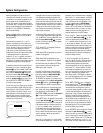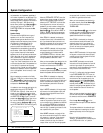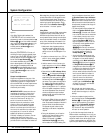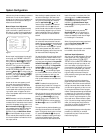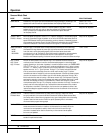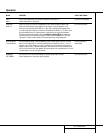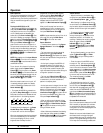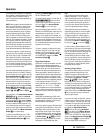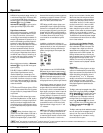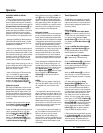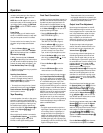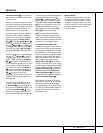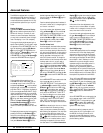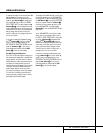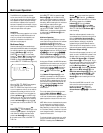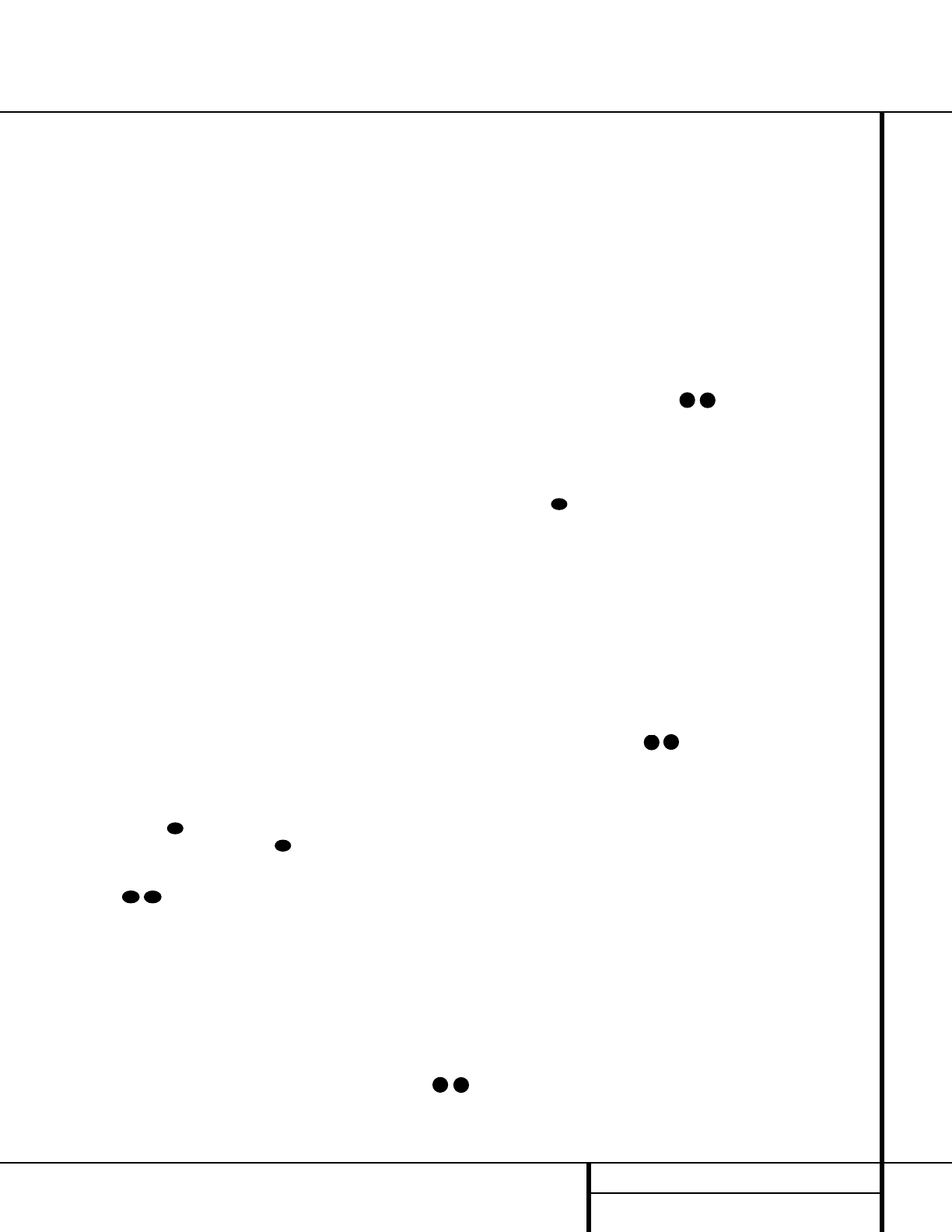
29 OPERATION
Operation
as Dolby Surround, DTS Stereo or UltraStereo®
may be played in either the Dolby Digital, Dolby
Pro Logic II Cinema, DTS Neo:6 Cinema, or
Logic 7 Cinema surround modes depending on
the source material.
NOTE: Once a program has been encoded with
matrix surround information, it retains the sur-
round information as long as the program is
broadcast in stereo. Thus, movies with surround
sound may be decoded via any of the analog
surround modes such as Pro Logic II Cinema,
Logic 7 Cinema or DTS Neo:6 Cinema, when
they are broadcast via conventional TV stations,
cable, pay-TV and satellite transmission. In addi-
tion, a growing number of made-for-television
programs, sports broadcasts, radio dramas and
music CDs are also recorded in surround sound.
You may view a list of these programs at the
Dolby Laboratories Web site at www.dolby.com.
Even when a program is not listed as carrying
intentional surround information, you may find
that the Pro Logic II, Logic 7 Enhanced or DTS
Neo:6,VMAx and the Hall or Theater modes
often deliver enveloping surround presentations
through the use of the natural information pres-
ent in all stereo recordings. However, for stereo,
but not surround programs, we suggest that you
experiment with the other modes.
Surround modes are selected using either the
front panel controls or the remote. To select a
surround mode from the front panel, press the
Surround Mode Selector 9 to scroll up or
down through the list of available modes. To
select a surround mode using the remote, first
determine which of the surround mode cate-
gories you wish to choose from and press the
button corresponding to that category:
Dolby
Modes
w, DTS Surround x from digital
sources,
DTS Neo:6 from analog sources,
Logic 7 y, DSP k modes or Stereo .
As you press any of the
Mode Select Buttons
wxy (except the Surround
Mode Selector
k as noted below) the sur-
round mode name will scroll across the
Main
Information Display
Y. Let the mode scroll
so that you read the mode’s name, but if you
wish to select another mode in that category,
press the button again before the mode name
scrolls off to the left of the
Main Information
Display
Y or on-screen display.
To select from the DSP modes (Hall 1, Hall 2,
Theater, VMAx Near or VMAx Far), first press
the
Surround Mode Selector k. Next,
press the
⁄
/
¤
Buttons n to scroll through
the list of available modes.
An individual mode indicator will also light up
DEGIJKLMN. As the surround
modes change, a green LED will light next to
the current mode in the
Surround Mode
Indicators
˘ list on the front panel.
Note that the Dolby Digital and DTS 5.1, DTS-
ES Matrix and DTS-ES Discrete modes may only
be selected when a digital input is in use. In
addition, when a digital source is present, the
AVR 520 will automatically select and switch to
the correct mode, regardless of the mode that
has been previously selected. For more informa-
tion on selecting digital sources, see the follow-
ing section of this manual.
To listen to a program in traditional two-chan-
nel stereo, using the front left and front right
speakers only (plus the subwoofer, if installed
and configured), press the
Stereo Button
until SURR OFF
appears in the Main
Information Display
Y.
Digital Audio Playback
Digital audio is a major advancement over older
analog surround processing systems such as
Dolby Pro Logic. It delivers five discrete channels:
left front, center, right front, left surround and
right surround. Each channel reproduces full fre-
quency range (20Hz to 20kHz) and offers dra-
matically improved dynamic range and significant
improvements to signal-to-noise ratios. In addi-
tion, digital systems have the capability to deliver
an additional channel that is specifically devoted
to low-frequency information.This is the “.1”
channel referred to when you see these systems
described as “5.1,”“6.1” or “7.1”. The bass
channel is separate from the other channels, but
since it is intentionally bandwidth-limited, sound
designers have given it that unique designation.
Dolby Digital
Dolby Digital is a standard part of DVD, and is
available on specially encoded LD discs and satel-
lite broadcasts and it is a part of the new high-
definition television (HDTV) system.
Note that an optional, external RF demodulator
is required to use the AVR 520 to listen to the
Dolby Digital sound tracks available on laser
discs. Connect the RF output of the LD player
to the demodulator and then connect the digi-
tal output of the demodulator to the
Optical
or Coaxial Inputs *Ó of the AVR
520. No demodulator is required for use with
DVD players or DTS-encoded laser discs.
DTS
DTS is another digital audio system that is
capable of delivering 5.1 or 6.1 discrete or
matrix soundfield reproduction. Although both
DTS and Dolby Digital are digital, they use dif-
ferent methods of encoding the signals, and
thus they require different decoding circuits to
convert the digital signals back to analog.
DTS-encoded sound tracks are available on
select DVD and LD discs, as well as on special
audio-only DTS discs. You may use any LD or
CD player equipped with a digital output to
play DTS-encoded discs with the AVR 520. All
that is required is to connect the player’s out-
put to either the
Optical or Coaxial Input on
the rear panel or front panel
*Ó.
In order to listen to DVDs encoded with DTS
sound tracks, the DVD player must be compati-
ble with the DTS signal as indicated by a DTS
logo on the player’s front panel. Note that early
DVD players may not be able to play DTS-
encoded DVDs. This does not indicate a prob-
lem with the AVR 520, as some players cannot
pass the DTS signal through to the digital out-
puts. If you are in doubt as to the capability of
your DVD player to handle DTS discs, consult
the player’s owner’s manual.
Selecting a Digital Source
To utilize either digital mode, you must have
properly connected a digital source to the
AVR 520. Connect the digital outputs from
DVD players, HDTV receivers, satellite systems
or CD players to the
Optical or Coaxial
Inputs
*Ó. In order to provide a
backup signal and a source for analog stereo
recording, the analog outputs provided on digi-
tal source equipment should also be connected
to their appropriate inputs on the AVR 520 rear
panel (e.g., connect the analog stereo audio
output from a DVD to the
DVD Audio Inputs
§ on the rear panel when you connect the
source’s digital outputs).
If you have not already configured an input for
a digital source using the on-screen menus as
shown on page 21, first select the input using
the remote or front panel controls as outlined
in this manual. Next, select the digital source
by pressing the
Digital Select Button
qÛ and then using the
⁄
/
¤
Buttons
n on the remote or the Selector Buttons
7$ on the front panel to
choose any of the
OPTICAL or COAXIAL
inputs, as they
appear in the
Main Information Display Y
display indicator BF or on-screen display.
When the digital source is playing, the
32
31
32
31
32
31
29
30
29
29
30



